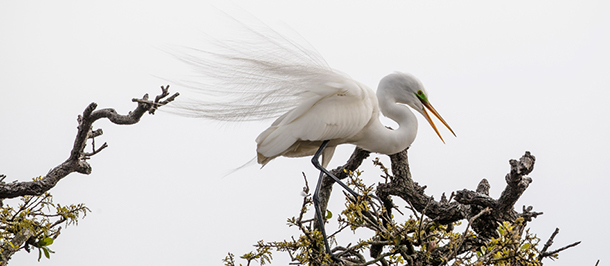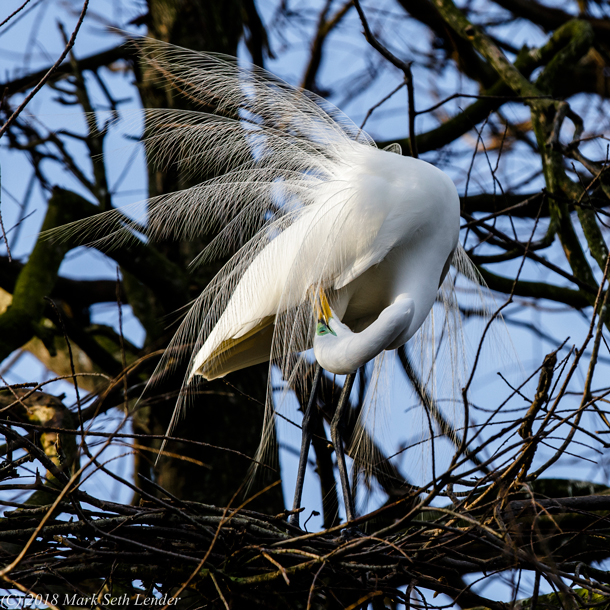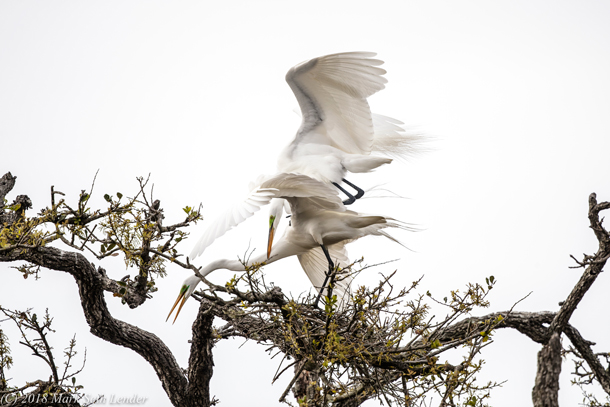A Great Egret’s Mating Dance
Air Date: Week of March 1, 2019

A male Great Egret in his breeding plumage. (Photo: Mark Seth Lender)
As spring approaches in Florida, male Great Egrets are practicing showing off their snowy white plumage for mates. Living on Earth’s Explorer in Residence, Mark Seth Lender, bears witness
Transcript
[EGRET CALLS]
CURWOOD: Long-legged egrets make their living fishing in shallow waters from Washington State through Central America. They are year-round residents in the Gulf states, including Florida where Living on Earth’s Explorer in Residence, Mark Seth Lender, found a Great Egret getting ready for an early spring.
Not Narcissus
Great Egret
St. Augustine
© 2018 Mark Seth Lender
All Rights Reserved
In the leafless somnambulance of winter the tree sways in the wind, and has not recognized that by all the other purposes of Life it is already spring. The warmth that should be early April has arrived a month too soon. The Order of disorder rules.

A male Great Egret preens his feathers. (Photo: Mark Seth Lender)
White as the snow that never falls here, white as the clouds that pillow on the sky, white as sequins sewn to the wedding suit of some mysterious groom, now Great Egret has arrived, and found a place of standing. The quills that descend from his back are falling water, the color of his face is emeralds of high degree, his bill is electrum. Canary yellow diamonds are his eyes. He is radiance. He is the glow that displays upon the sunrise sky.
Great Egret bows, the long neck reaches down, the long bill taps sharply on the branches below the branch where he stands (to show how he will find substance for the nest; how he will strike the water to capture fish). He stretches towards the blue above him (to show the way he will defend eggs, then young, and challenge all intruders and unwanted suitors). He strops the feathers and the long decorating quills vibrating along his sides (to show by his perfection how fit he is for the tasks he promises to perform). He sways side to side (a demonstration that his balance is unshakable). He looks straight and long (taking the parallax view of any danger lurking near or far).

Great Egrets breed in trees close to wetlands. (Photo: Mark Seth Lender)
And just in case you think all this is rote, that he has no idea what it’s all about, and who it’s all for? When the dance is done, like any single dancing son alone at a high school prom, he looks all around as casually as possible so that you’d hardly notice it – a glance here, a glance there – in hope that at the very least, just one of the girls was watching.
CURWOOD: Living on Earth’s Explorer in Residence, Mark Seth Lender.
Links
Thanks this week to St. Augustine Alligator Farm Zoological Park
Living on Earth wants to hear from you!
Living on Earth
62 Calef Highway, Suite 212
Lee, NH 03861
Telephone: 617-287-4121
E-mail: comments@loe.org
Newsletter [Click here]
Donate to Living on Earth!
Living on Earth is an independent media program and relies entirely on contributions from listeners and institutions supporting public service. Please donate now to preserve an independent environmental voice.
NewsletterLiving on Earth offers a weekly delivery of the show's rundown to your mailbox. Sign up for our newsletter today!
 Sailors For The Sea: Be the change you want to sea.
Sailors For The Sea: Be the change you want to sea.
 The Grantham Foundation for the Protection of the Environment: Committed to protecting and improving the health of the global environment.
The Grantham Foundation for the Protection of the Environment: Committed to protecting and improving the health of the global environment.
 Contribute to Living on Earth and receive, as our gift to you, an archival print of one of Mark Seth Lender's extraordinary wildlife photographs. Follow the link to see Mark's current collection of photographs.
Contribute to Living on Earth and receive, as our gift to you, an archival print of one of Mark Seth Lender's extraordinary wildlife photographs. Follow the link to see Mark's current collection of photographs.
 Buy a signed copy of Mark Seth Lender's book Smeagull the Seagull & support Living on Earth
Buy a signed copy of Mark Seth Lender's book Smeagull the Seagull & support Living on Earth

